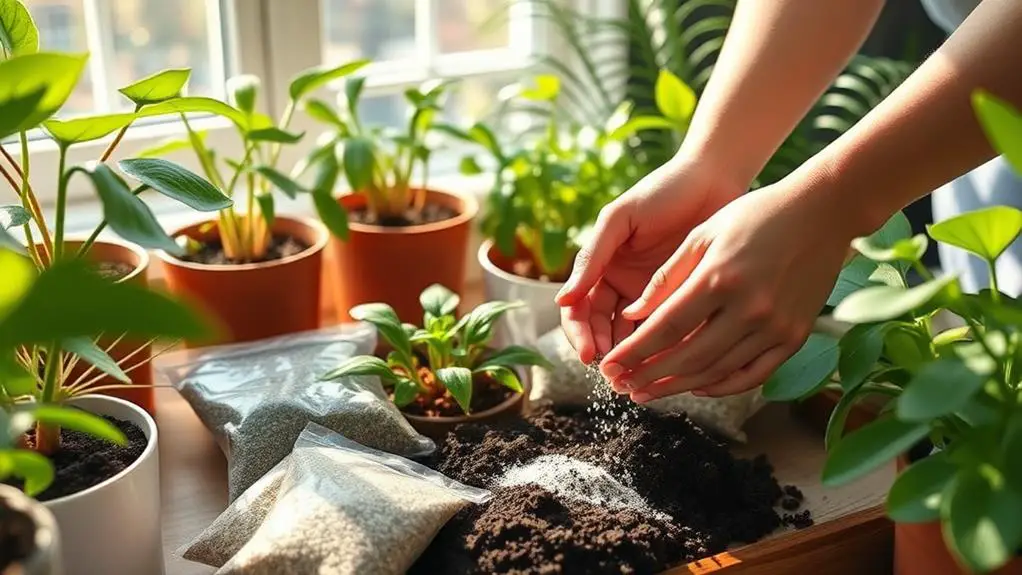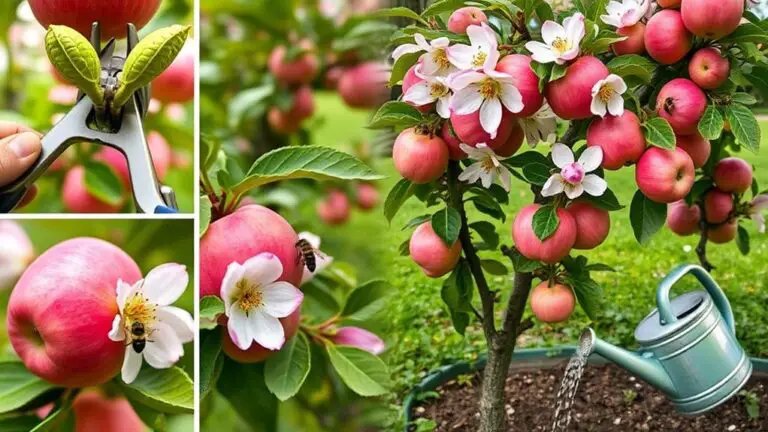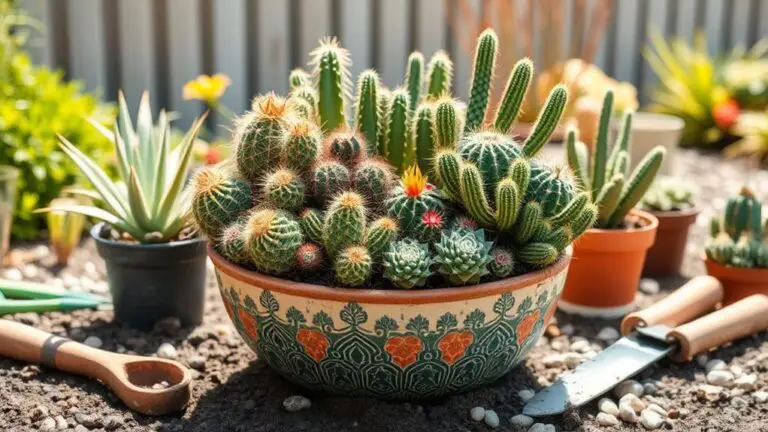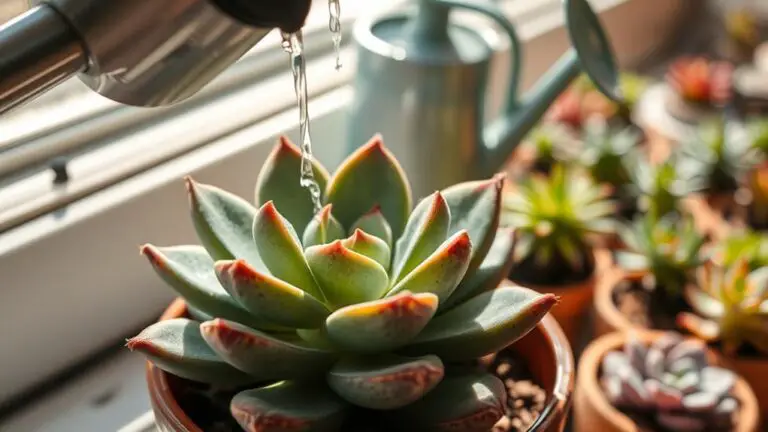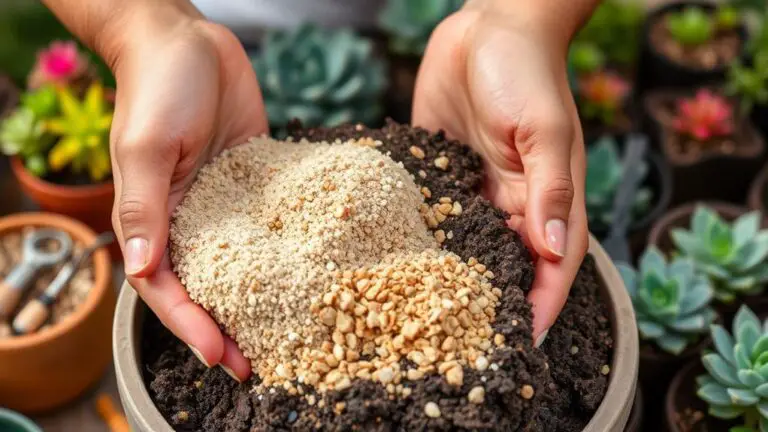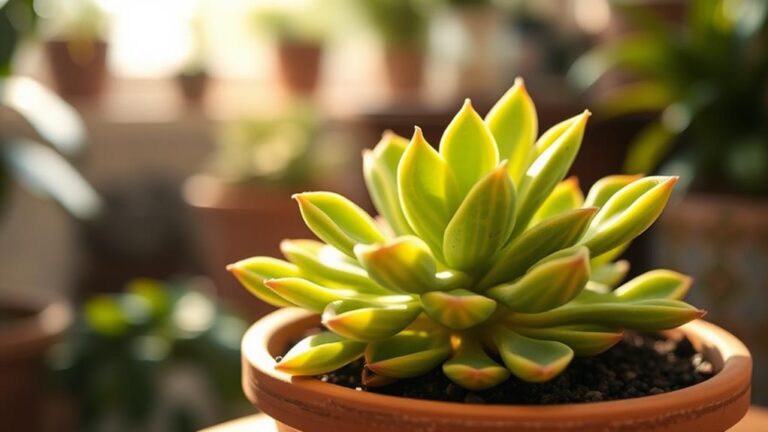7 Steps to Fertilize Your Houseplants: Complete Guide
When it comes to fertilizing your houseplants, knowing the proper steps can make all the difference in their health and vibrancy. You might think any fertilizer will do, but selecting the right type and understanding N-P-K ratios are vital first steps. Once you've chosen the appropriate fertilizer, preparing the solution correctly is important to avoid damaging your plants. But that's just the beginning. What about the timing, application methods, and avoiding common pitfalls like over-fertilization? Each step plays a pivotal role, and mastering them will guarantee your houseplants thrive. So, what's the next vital step to contemplate?
Choose the Right Fertilizer
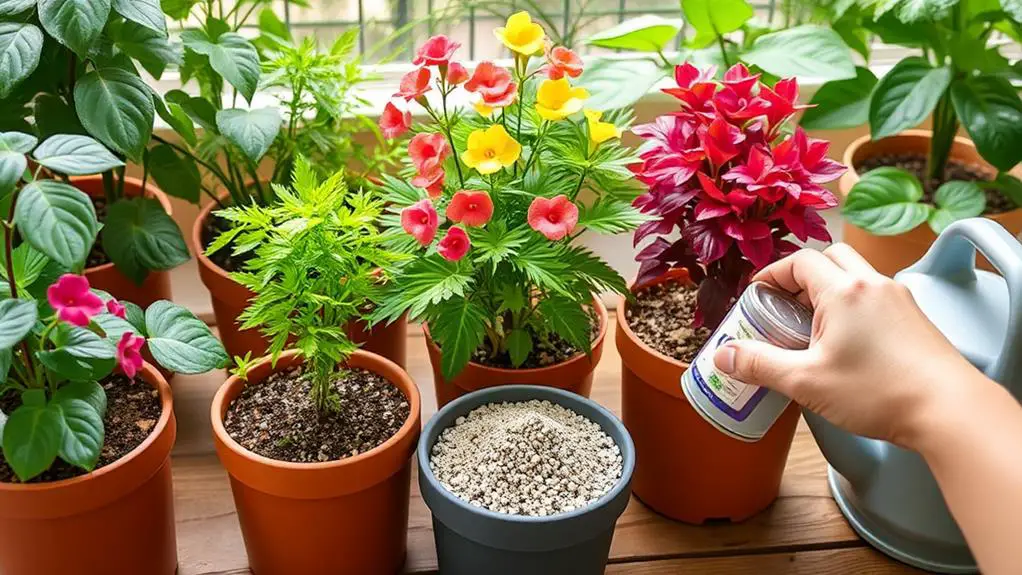
Choosing the right fertilizer is essential for the health and vibrancy of your houseplants. You'll want to make certain your plants get the essential nutrients they need for healthy growth. A water-soluble fertilizer is a great choice because it helps deliver these essential nutrients, such as nitrogen, phosphorus, and potassium, directly to your plants.
When fertilizing plants, it's important to pay attention to the N-P-K ratio on the fertilizer label. This ratio tells you the balance of nitrogen (N), phosphorus (P), and potassium (K) in the product. For most houseplants, a balanced N-P-K ratio like 10-10-10 works well.
Organic fertilizers, like fish emulsion, are another excellent option. They release nutrients slowly and gently, making them safer for your plants compared to synthetic ones.
However, always ascertain proper dilution to avoid root burn. Typically, mixing between ¼ to ½ teaspoon of fertilizer per gallon of water is ideal.
Understand N-P-K Ratios

Understanding N-P-K ratios is vital for anyone looking to properly fertilize their houseplants. The N-P-K ratio on fertilizer packaging indicates the concentration of nitrogen (N), phosphorus (P), and potassium (K). These are essential macronutrients for plant growth.
For example, a fertilizer with a 10-5-8 N-P-K ratio contains 10% nitrogen, 5% phosphorus, and 8% potassium by weight. This ratio influences the fertilizer's suitability for different plant types.
Higher nitrogen levels (the first number) support leafy growth, making them ideal for foliage plants. On the other hand, higher phosphorus (the second number) is important for flowering plants to promote blooming.
Prepare Fertilizer Solution
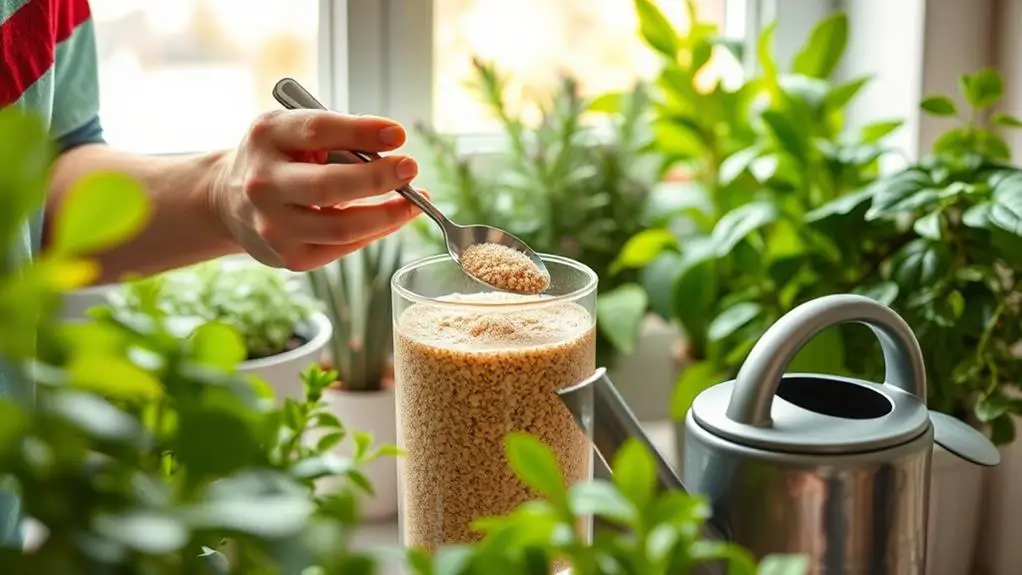
To prepare your fertilizer solution, start by mixing ¼ to ½ teaspoon of water-soluble fertilizer per gallon of water for the best nutrient delivery.
Always water your plants with plain water first to prevent root burn and help them absorb the fertilizer better.
If you're using a fish emulsion fertilizer, don't worry if it smells strong at first; the odor will disappear in a day or two.
Proper Dilution Ratios
Preparing the right fertilizer solution for your houseplants is vital for their health and growth. To start, use a water-soluble fertilizer and mix ¼ to ½ teaspoon per gallon of water. This dilution ratio guarantees proper nutrient delivery without harming your plants.
Before applying the fertilizer, always water your houseplants to prevent root burn and help them absorb the nutrients better.
When using fish emulsion fertilizers, keep in mind that they might've a strong odor. Don't worry; the smell will dissipate within 1-2 days.
After you've fertilized, it's important to empty any excess fertilizer water from the runoff dishes. Prolonged exposure to nutrient-rich water can damage the roots.
Mixing Techniques Explained
When it comes to mixing your fertilizer solution, precision is key to ensuring your houseplants thrive. Start by diluting ¼ to ½ teaspoon of water-soluble fertilizer per gallon of water. This helps prevent any potential harm to your plants.
Always water your plants before applying the fertilizer. Moist soil is important because it enhances nutrient absorption, ensuring your plants get the most out of the fertilizer.
If you're using fish emulsion fertilizers, keep in mind that they might've an initial odor. Don't worry, it usually goes away within a day or two. Fish emulsion is a great organic option.
After applying the fertilizer, make sure to empty any excess fertilizer water from runoff dishes. Standing water can damage your plant's roots, so it's crucial to avoid it.
Using specialized sprayers can make the application process more efficient. They help you achieve even distribution across the plant's foliage, ensuring every part of your plant gets the nutrients it needs.
Water Before Fertilizing
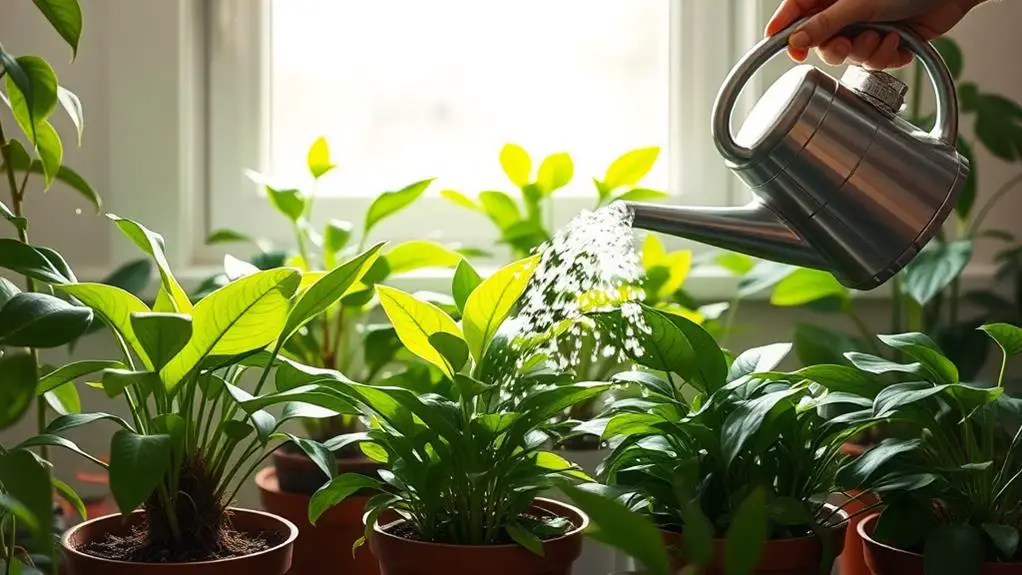
Watering your houseplants before fertilizing is essential to prevent root burn and guarantee better nutrient absorption. Confirming the soil is moist allows the nutrients to be absorbed effectively. Here's why you should always water before fertilizing:
- Prevent Root Burn: Applying fertilizer to dry soil can lead to concentrated fertilizer contact with roots, causing root burn. Moist soil helps distribute nutrients evenly.
- Enhanced Nutrient Absorption: Watering thoroughly before fertilizing guarantees that the soil is damp, which promotes better nutrient movement through the root system.
- Dilute Fertilizer: Excess moisture from watering can help dilute the fertilizer when applied, reducing the risk of damage to your plants.
- Prevent Root Damage: After fertilizing, it's essential to empty any excess fertilizer water from runoff dishes to avoid nutrient buildup and potential root damage.
Fertilizing houseplants right after watering makes certain the roots can take up the nutrients more efficiently.
It's a simple step but makes a huge difference in keeping your plants happy and healthy.
Remember, the key is to maintain moist soil and monitor for excess moisture to protect your plants from any harm.
Following these steps will help your houseplants thrive, confirming they get the nutrients they need without the risk of root burn.
Apply Fertilizer Properly
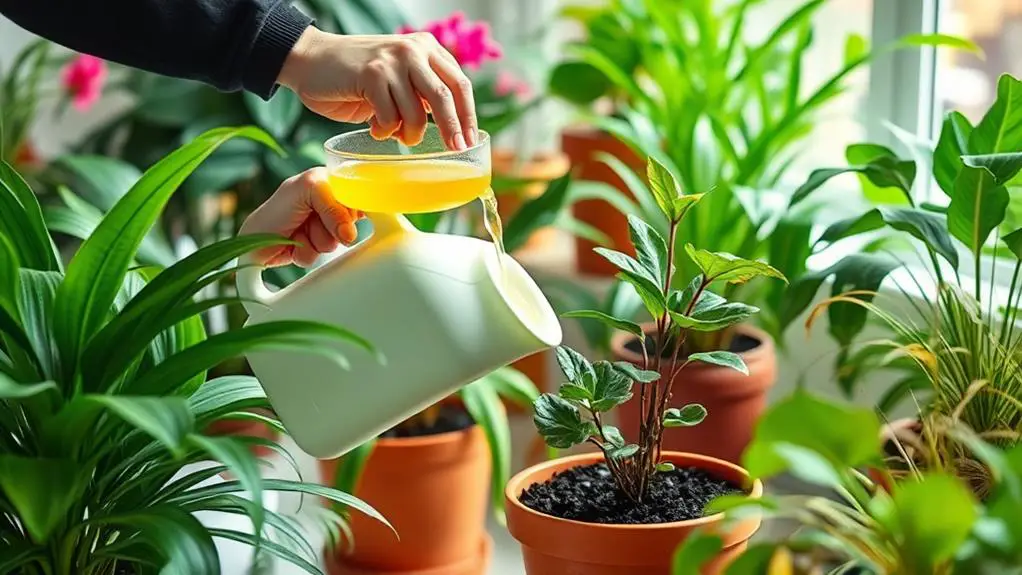
Applying fertilizer properly is essential for maintaining healthy houseplants. First, make certain to water your plants before you apply fertilizer. This helps prevent root burn and guarantees the nutrients are absorbed better when the soil is moist.
For best results, use a water-soluble fertilizer, diluting it to a concentration of ¼ to ½ teaspoon per gallon of water.
During the active growing season, from late March to mid-September, you should fertilize every 2-3 weeks. Avoid fertilizing in fall and winter when your plants aren't actively growing. Always be careful to remove any excess fertilizer water from the drainage dishes after application. This prevents root damage caused by standing water.
If you notice signs of nutrient deficiency, like yellowing leaves or stunted growth, you may need to adjust your fertilizing routine. On the other hand, if the leaves turn brown or crispy, it could be a sign of over-fertilization. In such cases, reduce the frequency or concentration of the liquid fertilizer.
For an organic option, you can also use compost tea. It's a great way to give your plants a nutrient boost without the risk of chemical build-up.
Monitor Plant Growth
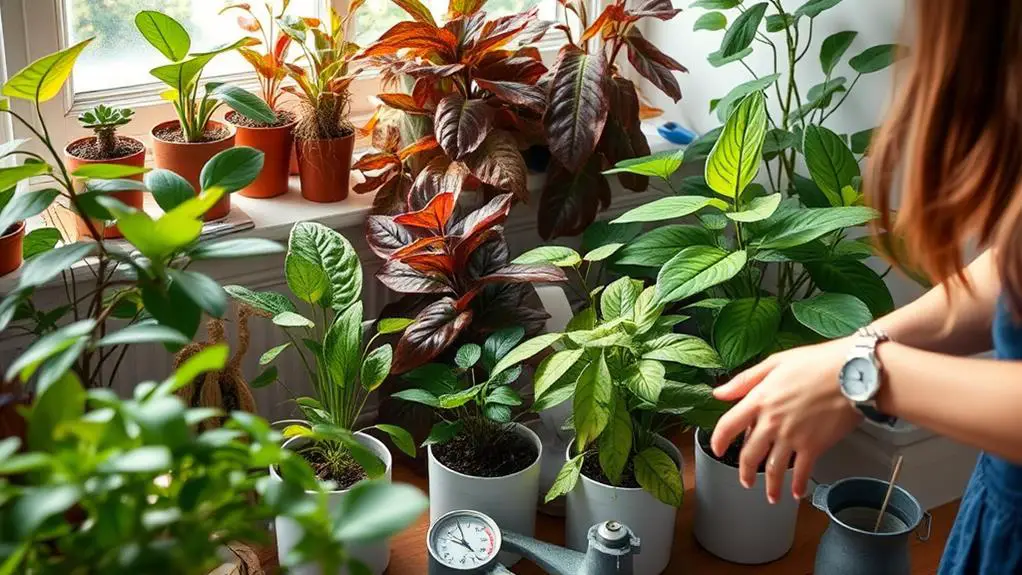
Keeping a close eye on your plant's growth is essential for guaranteeing its health and vigor. Regularly observe your plant's growth patterns to catch any early signs of trouble. Healthy growth includes vibrant foliage and new leaf production, showing that your plant is actively utilizing nutrients.
Here's how you can effectively monitor plant growth:
- Check Leaf Color: Pale or yellowing leaves may suggest nutrient deficiencies, while dark green foliage can indicate sufficient nitrogen levels.
- Note New Growth: Keep an eye on the size and health of new leaves. Stunted or smaller leaves might mean your plant needs more fertilizer or a change in care practices.
- Assess Root Health: Confirm the roots aren't overcrowding the pot. Root-bound plants can show slowed growth and have trouble absorbing nutrients.
- Document Responses: Keep a record of your plant's responses to fertilization over time. Adjust your fertilization schedule based on observed growth trends and seasonal changes, especially during active growth periods.
Adjust Fertilization Schedule

Observing your plant's growth provides valuable insights into its nutritional needs. Adjusting your fertilization schedule based on seasonal growth patterns is vital.
Start fertilizing in early spring, when plants begin actively growing. During this period, from late March to mid-September, you should fertilize every 2-3 weeks. This helps provide the necessary nutrients for robust growth.
As fall approaches, reduce frequency. Most houseplants enter a dormancy period during fall and winter. You can cut back to fertilizing once a month or even less to prevent over-fertilization. Overfeeding can lead to root burn and other issues, especially in low-light plants.
Monitoring plant health is essential. If you notice slowed growth or changes in the leaf appearance, it might be time to adjust your fertilization routine.
For example, some plant types, like succulents and cacti, only need fertilization every 6 weeks, while heavy feeders may require more frequent applications.
Newly potted plants need special attention. Delay fertilization for 2-3 months after potting to avoid stressing them.
Always remember that different plant types have unique needs, so tailor your approach accordingly to keep your houseplants thriving.
Frequently Asked Questions
How to Properly Fertilize Indoor Plants?
Start fertilizing in late March through mid-September. Use a diluted water-soluble fertilizer every 2-3 weeks. Water plants beforehand, choose the right N-P-K ratio, and avoid fertilizing during dormancy. Adjust based on plant health.
Should You Water Plants Before or After Fertilizing?
You should water your plants before fertilizing. This guarantees the soil is moist, preventing root burn and enhancing nutrient absorption. After watering, use a diluted fertilizer solution and empty any excess water to protect the roots.
What Houseplants Don't Like Fertilizer?
Plants like succulents, cacti, snake plants, pothos, ZZ plants, and many ferns don't need much fertilizer. Over-fertilizing can harm them, causing root burn and poor health. Understand each plant's needs to avoid issues.
What Numbers of Fertilizer for Houseplants?
Look for a balanced fertilizer with an N-P-K ratio like 10-10-10 for general houseplant care. Flowering plants often need higher phosphorus, so a 10-20-10 or 10-30-10 formula works best. Choose based on your plant's needs.
Conclusion
You've got the tools to keep your houseplants thriving! By choosing the right fertilizer, understanding N-P-K ratios, and preparing your solution properly, you're off to a great start. Remember to water before fertilizing and apply it carefully. Keep an eye on your plants, adjusting your schedule as needed. Don't worry—mistakes happen, and plants are resilient. With these steps, you're well on your way to becoming a confident, successful indoor gardener. Happy growing!

